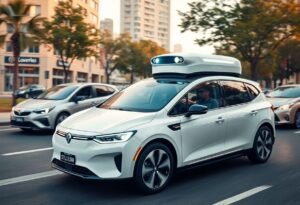The future of autonomous vehicles and smart traffic systems stands at the forefront of innovation. As technology continues to evolve, the integration of autonomous cars with intelligent traffic management systems promises to reshape urban mobility and enhance safety on our roads.
Transforming Urban Landscapes with Autonomous Vehicles
As cities expand, the introduction of autonomous vehicles is revolutionizing urban planning. These vehicles rely on advanced computing algorithms and machine learning to navigate complex environments. Traditional traffic patterns are becoming obsolete, replaced by dynamic systems that allow for real-time responses to traffic conditions. The integration of these vehicles into urban infrastructure can significantly reduce congestion, leading to smoother flows of traffic. This transformation poses opportunities for cities to redesign public spaces, reducing reliance on parking and allowing for greener, pedestrian-friendly environments.
Smart Traffic Systems Enhancing Safety
The rise of smart traffic systems is pivotal in improving road safety. Through automation technologies and real-time data analysis, traffic signals can be adjusted instantly based on vehicle density and pedestrian crossings. Studies show that such systems can reduce accident rates by 20% or more. Coupled with autonomous vehicles, these intelligent traffic solutions significantly lower human error, one of the leading causes of traffic accidents, hence, increasing overall road safety.
The Role of AI in Traffic Management
Artificial Intelligence (AI) plays a crucial role in managing smart traffic systems. By processing vast amounts of data from various sources such as cameras, sensors, and GPS, AI can make predictive adjustments to traffic flow. This ensures optimal vehicle movement and minimizes delays. Furthermore, AI enables autonomous vehicles to communicate with each other and with infrastructure, enhancing coordination and efficiency. The ongoing advancements in artificial intelligence are laying the groundwork for completely automated traffic ecosystems.
Reducing Environmental Impact
One of the significant benefits of autonomous vehicles and smart traffic systems is their potential to reduce greenhouse gas emissions. Cars that utilize AI and machine learning can optimize driving patterns, lower fuel consumption, and reduce emissions by driving more efficiently. Additionally, with the advent of electric autonomous vehicles, the impact on the environment can be minimized substantially. Integrating these technologies into city planning promotes a more sustainable urban environment while addressing climate change.
Public Acceptance of Autonomous Technology
While the technology behind autonomous vehicles and smart traffic systems is advancing rapidly, public acceptance remains a challenge. Educating the public about the safety and efficiency of these systems is essential for widespread adoption. Through continuous engagement and transparent communication, societal concerns can be addressed, paving the way for smoother integration into daily life. Building trust will be integral in ensuring these innovations are embraced by urban communities.
Future Innovations in Autonomous Transportation
The future promises even more innovative solutions in autonomous transportation. Concepts like vehicle-to-everything (V2X) communication will allow vehicles to interact with each other, road signs, and traffic lights, further enhancing safety and efficiency. Pilots and prototypes are already being tested in numerous cities, showcasing the transformative potential of autonomous transport. As these technologies mature, we can expect a very different landscape of urban mobility in just a few years, offering us a glimpse into a futuristic world where autonomous vehicles are the norm.
Disclaimer: The information provided in this article is for informational purposes only and should not be considered as professional advice or endorsements.





















